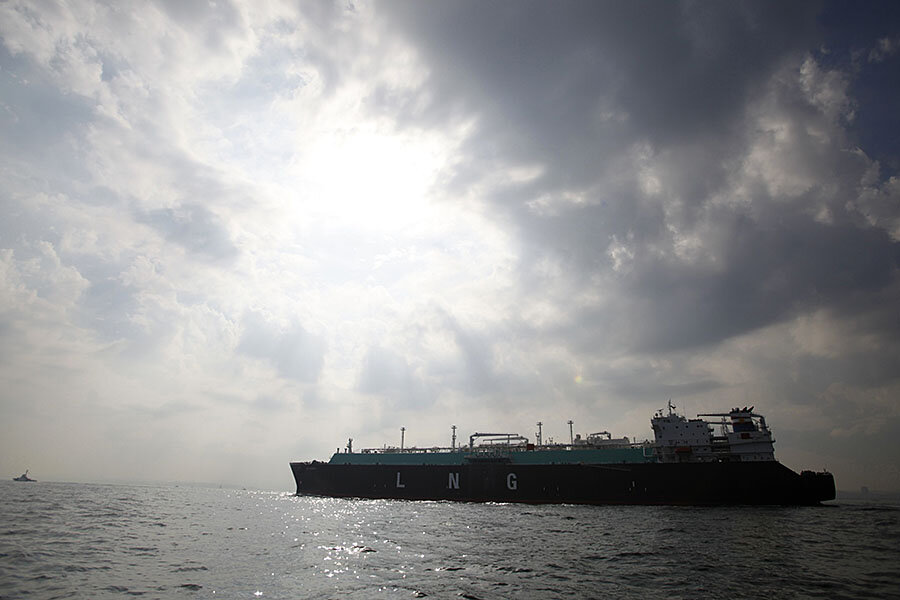Pacific trade deal or no, Japan eyes US gas riches
Loading...
The world’s fourth-largest energy consumer has been on the lookout for new supplies.
Ever since 2011’s Fukushima disaster, Japan has run its economy without nuclear power, which once provided more than a quarter of its electricity. The resource-poor island nation has filled the gap mostly with costly imported coal and natural gas, while also expanding deployment of renewable power.
Now, Japan is looking across the Pacific Ocean toward an ally awash in new energy supplies. Japanese firms already buy millions of cubic feet of natural gas from the US. That energy dynamic could accelerate and expand if a trans-Pacific trade deal under debate in Congress this week gets a go-ahead.
It’s one reason Japan joined the Trans-Pacific Partnership, a wide-ranging trade agreement between 12 nations, back in 2013. TPP would give Japan and other countries a more favorable status when it comes to getting the approvals companies need to ship liquefied natural gas (LNG) overseas.
Still, TPP’s impact on US-Japan energy trade might not be as large as it seems – at least not in the short term. Analysts say that depressed global gas prices combined with Japan’s preexisting contractual obligations, could limit the trade deal’s impact on global LNG flows.
“Passage of the TPP would not have a significant impact on our LNG trade with Japan,” says Tom Cutler, president of Cutler International, a consulting firm. “I’m sure it will have important implications in other parts of our trading relationship but in terms of LNG I think [Japan] feel[s] they’ve already got what they need.”
US law requires energy firms to get special permission to export natural gas to countries, like Japan, that do not have a free trade agreement with the US. That hasn’t stopped Japan from claiming a stake in the supplies those projects will one day ship. Of the four US LNG projects that have received final approval to export the fuel, Japanese companies have signed on to two directly, and one indirectly, according to a January Congressional Research Service report.
If all those projects are completed, US shipments of LNG to Japan could reach 594 billion cubic feet per year by 2019, according to Mr. Cutler, who previously served as director of the office of European and Asia-Pacific affairs at the Department of Energy. That would account for 14 percent of Japan’s LNG needs, and could eventually grow to 20 percent, according to internal Japanese statistics cited by Cutler. Such an increase would make the US the No. 1 supplier of LNG to Japan, with or without the passage of TPP.
“The amount of production and exports and where the energy products may be sold depends on many market factors, including prices and supply from other exporting countries,” Trevor Kincaid, deputy assistant US Trade Representative and spokesman, wrote in an e-mail. “Japan, the only large importer of LNG among the new [trade] partners in TPP, currently imports all of its LNG from other countries, including other TPP countries (Australia and Malaysia) and other countries such as Russia and Middle East. Currently, lower prices for LNG worldwide and in Asia may decrease the competitiveness of US exports.”
Shipping natural gas from the US to Asia has less of an economic appeal than it did back in 2013. Many gas contracts in Asia are linked to the price of oil, which declined by around 60 percent in the latter half of 2014 and early months of 2015. That downward pressure on Asian LNG prices means Japan might be better off getting the gas it needs from closer sources like Australia or Malaysia. And if Japan’s Prime Minister Shinzo Abe is successful in restarting the country’s nuclear program, the need for added LNG supplies would be diminished.
“It’s not clear [US LNG] will be that much cheaper in the end because you have to move it across the country, gassify it and transport it overseas,” says Joshua Meltzer, a fellow in global economy and development at the Brookings Institution. “But I think Japan is hoping in the long term that US LNG will push down Asian prices.”
In other words, by making it easier to trade with a wider range of LNG exporters, Japan would have more leverage in bargaining with its current suppliers. Cheaper gas could have big implications for a country struggling to meet its climate goals without carbon-free nuclear power. Japan is already planning 43 new carbon-heavy coal plants, according to a recent analysis by an environmental group, and analysts say it will need to dramatically boost renewable production and switch from coal to gas if it wants to meet or exceed its obligations as Paris climate talks approach in December. But while an increase in LNG imports might brighten the outlook for Japan’s emissions reductions, it may not be a net positive on the global scale.
“Exported LNG has a [greenhouse gas] footprint about 15% higher than onshore natural gas that we don’t export,” Michael Obeiter, a senior associate at the World Resources Institute, notes in an e-mail. “Liquefying, transporting, and regasifying LNG are all very energy-intensive.”
It's one reason the Sierra Club and other environmental groups oppose TPP, arguing that any carbon emissions reductions in switching from coal to gas are offset by methane leaks and other environmental impacts elsewhere.
"Automatic exports of natural gas would mean more fracking, more fossil fuel infrastructure, and more climate-disrupting emissions," Ilana Solomon, director of Sierra Club's responsible trade program writes in an e-mail. "It's also important to note that if the TPP passes, other countries will be able to join the pact even after it is complete, making an ever-expanding web of countries that have automatic access to fracked gas from the U.S."








